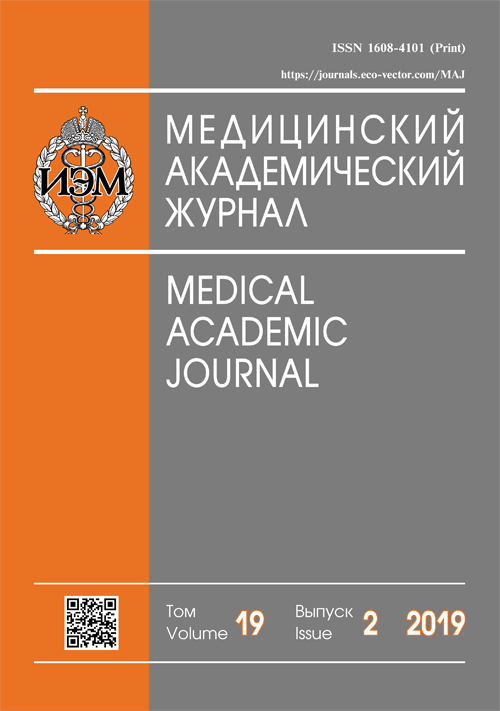Зависимость удельной активности участников обмена железа от степени компенсации сахарного диабета 2-го типа
- Авторы: Войнова И.В.1, Костевич В.А.1, Елизарова А.Ю.1, Карпенко М.Н.1, Соколов А.В.1,2
-
Учреждения:
- ФГБНУ «Институт экспериментальной медицины»
- ФГБОУ ВПО «Санкт-Петербургский государственный университет»
- Выпуск: Том 19, № 2 (2019)
- Страницы: 37-42
- Раздел: Оригинальные исследования
- Статья опубликована: 18.09.2019
- URL: https://journals.eco-vector.com/MAJ/article/view/16133
- DOI: https://doi.org/10.17816/MAJ19237-42
- ID: 16133
Цитировать
Полный текст
Аннотация
Цель исследования — проанализировать изменения активности участников обмена железа, церулоплазмина и трансферрина у пациентов с сахарным диабетом 2-го типа в зависимости от процентного содержания гликированного гемоглобина, который является биохимическим критерием степени компенсации хронической гипергликемии.
Материалы и методы. С помощью биохимических методов измерены концентрация и активность церулоплазмина и трансферрина, концентрация железа, меди, холестерина липопротеинов в сыворотке крови, полученной от здоровых доноров и пациентов с сахарным диабетом 2-го типа, объединенных в три группы в зависимости от процентного содержания гликированного гемоглобина.
Результаты. Обнаружены достоверное снижение концентрации меди, ферроксидазной активности церулоплазмина и способности трансферрина насыщаться железом, а также увеличение концентрации трансферрина при компенсированном и некомпенсированном сахарном диабете 2-го типа.
Заключение. Установлена статистическая связь степени компенсации сахарного диабета 2-го типа с активностью участников обмена железа. Так, по мере усиления гипергликемии снижается как активность церулоплазмина, так и насыщение трансферрина ионами железа. Выявленные изменения объясняют причину эффективности лечения хелаторами железа таких осложнений сахарного диабета 2-го типа, как трофические язвы, которые связаны с изменением оттока железа.
Ключевые слова
Полный текст
Об авторах
Ирина Витальевна Войнова
ФГБНУ «Институт экспериментальной медицины»
Email: iravoynova@mail.ru
аспирант, научный сотрудник отдела молекулярной генетики
Россия, Санкт-ПетербургВалерия Александровна Костевич
ФГБНУ «Институт экспериментальной медицины»
Email: hfa-2005@yandex.ru
ORCID iD: 0000-0002-1405-1322
SPIN-код: 2726-2921
канд. биол. наук, старший научный сотрудник отдела молекулярной генетики
Россия, Санкт-ПетербургАнна Юрьевна Елизарова
ФГБНУ «Институт экспериментальной медицины»
Email: anechka_v@list.ru
SPIN-код: 3059-4381
аспирант, научный сотрудник отдела молекулярной генетики
Россия, Санкт-ПетербургМарина Николаевна Карпенко
ФГБНУ «Институт экспериментальной медицины»
Email: mnkarpenko@mail.ru
ORCID iD: 0000-0002-1082-0059
SPIN-код: 6098-2715
канд. биол. наук, старший научный сотрудник физиологического отдела им. И.П. Павлова
Россия, Санкт-ПетербургАлексей Викторович Соколов
ФГБНУ «Институт экспериментальной медицины»; ФГБОУ ВПО «Санкт-Петербургский государственный университет»
Автор, ответственный за переписку.
Email: biochemsokolov@gmail.com
ORCID iD: 0000-0001-9033-0537
SPIN-код: 7427-7395
д-р биол. наук, заведующий лабораторией биохимической генетики отдела молекулярной генетики; профессор кафедры фундаментальных проблем медицины и медицинских технологий
Россия, Санкт-ПетербургСписок литературы
- Alfadhel M, Babiker A. Inborn errors of metabolism associated with hyperglycaemic ketoacidosis and diabetes mellitus: narrative review. Sudan J Paediatr. 2018;18(1):10-23. https://doi.org/10.24911/SJP.2018.1.3.
- Yoshida K, Furihata K, Takeda S, et al. A mutation in the ceruloplasmin gene is associated with systemic hemosiderosis in humans. Nat Genet. 1995;9(3):267-272. https://doi.org/10.1038/ng0395-267.
- Zheng J, Chen M, Liu G, et al. Ablation of hephaestin and ceruloplasmin results in iron accumulation in adipocytes and type 2 diabetes. FEBS Lett. 2018;592(3):394-401. https://doi.org/10.1002/1873-3468.12978.
- Pandey R, Dingari NC, Spegazzini N, et al. Emerging trends in optical sensing of glycemic markers for diabetes monitoring. Trends Analyt Chem. 2015;64:100-108. https://doi.org/10.1016/j.trac.2014.09.005.
- Kang JH. Oxidative modification of human ceruloplasmin by methylglyoxal: an in vitro study. J Biochem Mol Biol. 2006;39(3):335-338. https://doi.org/10.5483/BMBRep.2006.39.3.335
- Dutra F, Ciriolo MR, Calabrese L, Bechara EJ. Aminoacetone induces oxidative modification to human plasma ceruloplasmin. Chem Res Toxicol. 2005;18(4):755-760. https://doi.org/10.1021/tx049655u.
- Squitti R, Mendez AJ, Simonelli I, Ricordi C. Diabetes and Alzheimer’s disease: can elevated free copper predict the risk of the disease? J Alzheimers Dis. 2017;56(3):1055-1064. https://doi.org/10.3233/JAD-161033.
- Sokolov AV, Voynova IV, Kostevich VA, et al. Comparison of interaction between ceruloplasmin and lactoferrin/transferrin: to bind or not to bind. Biochemistry (Mosc). 2017;82(9):1073-1078. https://doi.org/10.1134/S0006297917090115.
- Osaki S. Kinetic studies of ferrous ion oxidation with crystalline human ferroxidase (ceruloplasmin). J Biol Chem. 1966;241(21):5053-5059.
- Golizeh M, Lee K, Ilchenko S, et al. Increased serotransferrin and ceruloplasmin turnover in diet-controlled patients with type 2 diabetes. Free Radic Biol Med. 2017;113:461-469. https://doi.org/10.1016/j.freeradbiomed.2017.10.373.
- Silva AM, Coimbra JT, Castro MM, et al. Determining the glycation site specificity of human holo-transferrin. J Inorg Biochem. 2018;186:95-102. https://doi.org/10.1016/j.jinorgbio.2018.05.016.
- Misra G, Bhatter SK, Kumar A, et al. Iron profile and glycaemic control in patients with type 2 diabetes mellitus. Med Sci (Basel). 2016;4(4):E22. https://doi.org/10.3390/medsci4040022.
- Topham RW, Frieden E. Identification and purification of a non-ceruloplasmin ferroxidase of human serum. J Biol Chem. 1970;245(24):6698-6705.
- Klenk DC, Hermanson GT, Krohn RI, et al. Determination of glycosylated hemoglobin by affinity chromatography: comparison with colorimetric and ion-exchange methods, and effects of common interferences. Clin Chem. 1982;28(10):2088-2094.
- Cegla UH. [Serum levels of alpha-2-macroglobulin, ceruloplasmin, transferrin, alpha-1-antitrypsin and complement (beta-1-C) before and following 3- and 6-day injections of D-penicillamine in man. (In German)]. Z Rheumatol. 1975;34(9-10):301-308.
- Sokolov AV, Kostevich VA, Romanico DN, et al. Two-stage method for purification of ceruloplasmin based on its interaction with neomycin. Biochemistry (Mosc). 2012;77(6):631-838. https://doi.org/10.1134/S0006297912060107.
- Sokolov AV, Pulina MO, Zakharova ET, et al. Effect of lactoferrin on the ferroxidase activity of ceruloplasmin. Biochemistry (Mosc). 2005;70(9):1015-1019. https://doi.org/10.1007/s10541-005-0218-9.
- Erel O. Automated measurement of serum ferroxidase activity. Clin Chem. 1998;44(11):2313-2319.
- Abe A, Yamashita S, Noma A. Sensitive, direct colorimetric assay of copper in serum. Clin Chem. 1989;35(4):552-554.
- Yamashita S, Abe A, Noma A. Sensitive, direct procedures for simultaneous determinations of iron and copper in serum, with use of 2-(5-Nitro-2-pyridylazo)-5-(N-propyl-N-sulfopropylamino)phenol (Nitro-PAPS) as ligand. Clin Chem. 1992;38(7):1373-1375.
- Elizarova AYu, Kostevich VA, Voynova IV, Sokolov AV. Lactoferrin as a promising remedy for metabolic syndrome therapy: from molecular mechanisms to clinical trials. Med Acad J. 2019;19(1):45-64. https://doi.org/10.17816/ MAJ19145-64.
Дополнительные файлы







